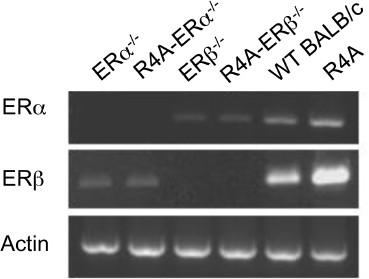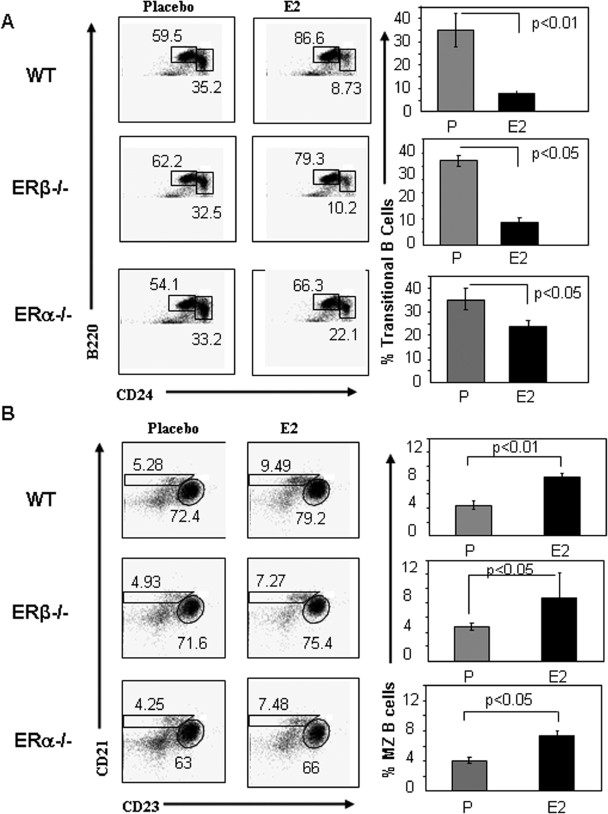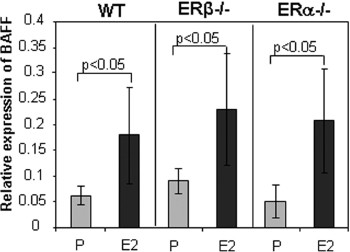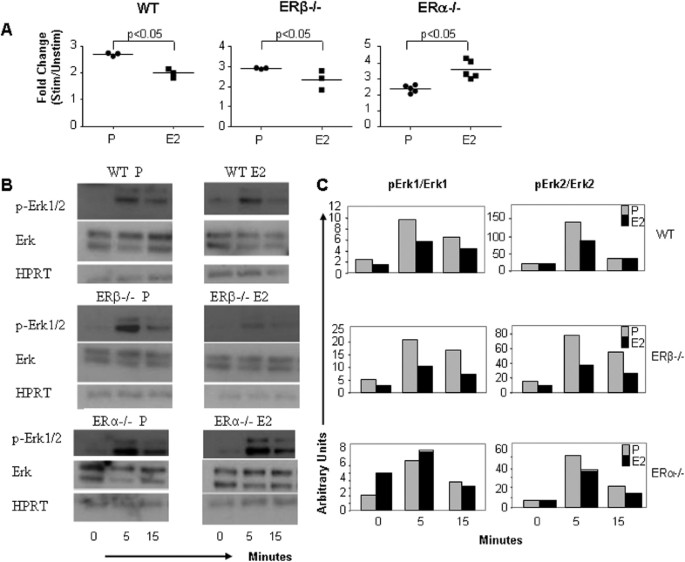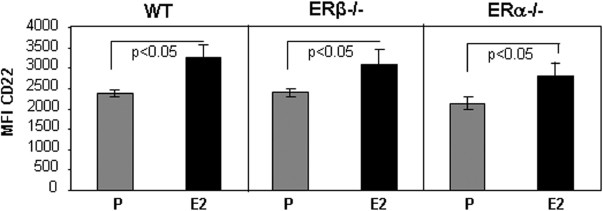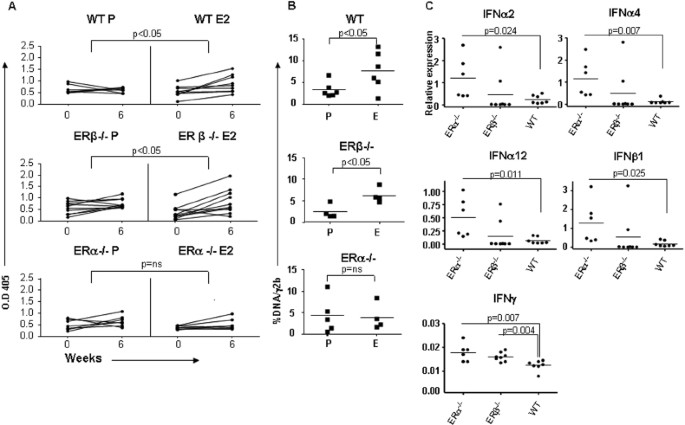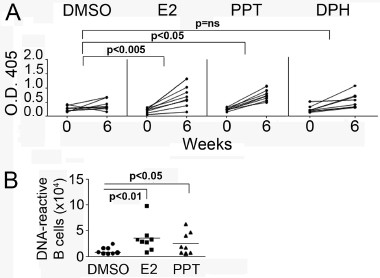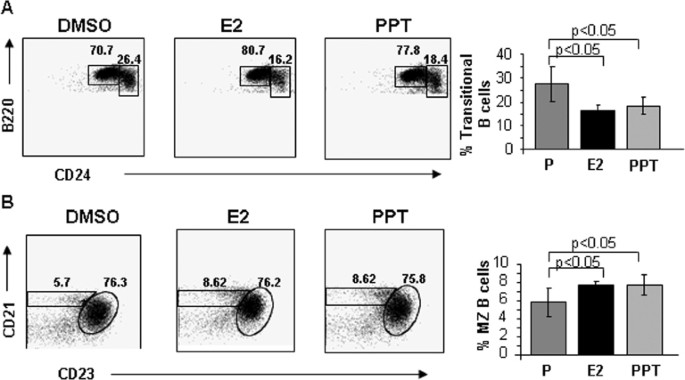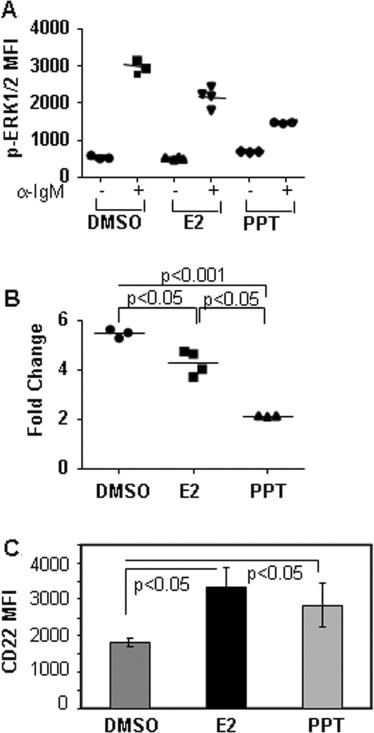Differential Roles of Estrogen Receptors α and β in Control of B-Cell Maturation and Selection (original) (raw)
- Research Article
- Open access
- Published: 22 November 2010
- Venkatesh Jeganathan1,
- Prameladevi Chinnasamy1,
- Christine Grimaldi1 nAff3 &
- …
- Betty Diamond1,2
Molecular Medicine volume 17, pages 211–220 (2011)Cite this article
- 1285 Accesses
- 94 Citations
- Metrics details
Abstract
It is clear that estrogen can accelerate and exacerbate disease in some lupus-prone mouse strains. It also appears that estrogen can contribute to disease onset or flare in a subset of patients with lupus. We have previously shown estrogen alters B-cell development to decrease lymphopoiesis and increase the frequency of marginal zone B cells. Furthermore, estrogen diminishes B-cell receptor signaling and allows for the increased survival of high-affinity DNA-reactive B cells. Here, we analyze the contribution of estrogen receptor α or β engagement to the altered B-cell maturation and selection mediated by increased exposure to estrogen. We demonstrate that engagement of either estrogen receptor α or β can alter B-cell maturation, but only engagement of estrogen receptor α is a trigger for autoimmunity. Thus, maturation and selection are regulated differentially by estrogen. These observations have therapeutic implications.
Introduction
Developing and maintaining an antibody repertoire that protects an organism from the multiple pathogens in the environment begins with B-cell ontogeny in bone marrow. Antibodies against numerous antigens are generated during the formation of a B-cell repertoire, and processes are required to limit the survival and maturation of those B cells making autoantibodies (1,2). Tolerance checkpoints occur at multiple times throughout B-cell development; a breakdown in one or more of these checkpoints lies at the crux of systemic lupus erythematosus (SLE). SLE is characterized by an array of antibodies against self-antigens (3,4). Anti-double-stranded (ds) DNA antibodies are the most common and are essentially diagnostic of SLE. Additionally, they have been demonstrated to contribute to tissue damage in kidney and possibly in brain (5–9).
The etiology of SLE is currently unknown, but experimental evidence in mouse models and clinical evidence in patients implicate both genetic susceptibility and environmental triggers (10,11). SLE disproportionately affects women, with a 9x greater incidence in women than in men (12). Although this occurrence may be in part determined by sex, there are data to support the role of sex hormones as a trigger for disease and a modulator of disease severity (13,14). Patients with SLE have been reported to have increased metabolism of more mitogenic forms of estrogen (15). In several mouse models, exogenous estradiol (E2) can accelerate and exacerbate disease (16–19).
We developed a transgenic BALB/c mouse that harbors the heavy chain of an IgG2b anti-DNA antibody (20,21). Transgene-expressing B cells have been shown to develop normally in the bone marrow and spleen. The BALB/c mouse normally maintains B-cell tolerance, deleting high-affinity DNA-reactive B cells and permitting the maturation to immunocompetence of low-affinity DNA-reactive B cells. Serum titers of anti-DNA antibody remain low (22,23). In the mouse, E2 acts as an environmental trigger for an SLE-like serology. E2 administration breaks B-cell tolerance in this mouse and permits the survival and activation of high-affinity DNA-reactive B cells, leading to elevated serum levels of anti-DNA antibody (22). Altered B-cell selection occurs at the immature and T2 transitional stages of B-cell development; the autoreactive B cells mature as marginal zone (MZ) B cells (24).
There are two estrogen receptors: estrogen receptor α (ERα) and estrogen receptor β (ERβ) (25). These form homodimers and heterodimers and are expressed in many cells including T cells, B cells, monocytes and dendritic cells (26–28). ERα and ERβ regulate gene transcription, having both overlapping and distinct target genes (29,30). Some reports suggest that they can function antagonistically (25). ERα can also function at the cell membrane to activate certain signaling cascades. Polymorphisms in ERα have been associated with SLE in studies of a small number of both Japanese and Swedish patients (31,32). Recently, it was shown that deletion of ERα in lupus-prone mice leads to reduced disease; the effect seems to be both a reduction in autoantibody production and an independent decrease in inflammation within the kidney itself (33,34).
Our interest has been the effect of E2 on B-cell maturation and selection. We chose to study the role of E2 on B-cell development and selection without the confounding factors present in an autoimmune background. E2 has been shown to decrease B-cell lymphopoiesis in the bone marrow at the pro-B-cell stage (35,36). We have previously shown that E2 alters B-cell subsets in the spleen. Because of the decreased lymphopoiesis in the bone marrow, there are fewer splenic transitional B cells. We also observed an E2-induced increase in the MZ B-cell compartment (24). Furthermore, E2 exposure causes a decrease in B-cell receptor (BCR) signaling in response to anti-IgM activation. This is accompanied by an E2-induced increase in expression of the negative regulator of the BCR, CD22 (24,37). These data led us to hypothesize that E2 dampens the BCR signal through an increased expression of CD22. We further hypothesized that the diminished BCR signal favored the generation of MZ B cells and allowed for survival of autoreactive B cells. Thus, we speculated that there was a relationship between the reduced BCR signal and the alteration in both B-cell maturation and selection.
Using BALB/c mice deficient in ERα or ERβ, we found that the decrease in transitional B cells and the expansion of the MZ B-cell compartment, which is seen in wild-type (WT) mice exposed to E2, was mediated by both ERα and ERβ. The E2-mediated reduction in BCR signal strength occurred in WT and ERβ-deficient mice, demonstrating that BCR signal strength is regulated by ERα. We further were able to demonstrate that ERα engagement led to a breakdown in B-cell tolerance, with increased survival to immunocompetence of high-affinity DNA-reactive B cells. Just as ERβ engagement did not alter BCR signal strength, ERβ engagement also did not alter B-cell selection. Thus, ERα may be a therapeutic target in some patients with SLE.
Materials and Methods
Mice and In Vivo Treatment
All mice were housed in a specific pathogen-free barrier facility, and experiments were performed according to the guidelines of the Institutional Animal Care and Use Committee. WT BALB/c mice, ERα-deficient (β-sufficient) and ERβ-deficient (α-sufficient) C57Bl/6 mice were obtained from Jackson Laboratories. ERα-and ERβ-deficient BALB/c mice were backcrossed to BALB/c mice for at least nine generations before homozygous ERα-or ERβ-deficient BALB/c mice were generated. ERα-and ERβ-deficient BALB/c mice were then mated to R4A-Tg BALB/c mice to produce ERα-or ERβ-deficient mice harboring the R4A transgene. Six-to ten-wk-old mice were ovariectomized, and time-release pellets, estradiol (E2) or placebo (P) (Innovative Research of America, Sarasota, FL, USA) were implanted subcutaneously for 3–6 wks as described (22). The E2 pellets maintain serum E2 concentrations of 75–100 pg/mL. In some studies, 100 µg 4,4′,4″-(4-propyl-[1H]pyrazole-1,3,5-triyl) Tris-phenol (PPT), the ERα agonist; 100 µg diarylpropionitrile (DPN), the ERβ agonist; and 2 µg E2 or vehicle (DMSO) was given daily by subcutaneous injection for 3 or 6 wks (38).
Flow Cytometry and Antibodies
Fluorophore-coupled antibodies specific for B220, Erk1/2, CD21, CD23 and CD22 were purchased from BD Pharmingen (San Jose, CA, USA). Fluorophore-coupled antibody to CD23 and CD24 (M1/69) were obtained from Caltag Laboratories (Burlingame, CA, USA). Antibody to AA4.1 was purchased from eBioscience. Extracellular staining was performed by using a crystallizable fragment (Fc) receptor block for 20 min followed by incubation with antibody for 30 min in 0.2% bovine serum albumin (BSA)/phosphate-buffered saline (PBS) at 4°C. For intracellular staining, cells were fixed and permeabilized with cytofix/cytoperm. Antibodies were diluted in cytoperm. Phosphoflow cytometry was performed using protocol from BD Biosciences (San Jose, CA, USA). Splenocytes were stimulated with 20 µg/mL anti-IgM F(ab)′2 antibody for 5 min at 37°C. Cells were stained with B-cell surface markers, and intracellular staining was performed using antibodies to phospho Erk. Flow cytometry was performed on an LSR II (BD Biosciences) and analyzed using Flowjo software (Tree Star, Ashland, OR, USA).
Single-Cell PCR of Light Chain Genes
Splenocytes were stained with antibodies specific for B220, IgG2b and AA4.1, and mature (B220+/Tg+/AA4.1−) cells were individually sorted into 96-well plates using a FACSAria (BD Biosciences). Single-cell RT-PCR was performed as described previously (39). Kappa light chain transcripts were amplified by two rounds of PCR. The following primers were used: universal Vκ 5′-GGCTGCAGSTTCAGTGGCAG TGGRTCWGGRAC-3′ + constant region primer (Cκ) (first round) 5-′TGGAT GGGTGGGAAGATG-3′; and Cκ (second round) 5′-AAGATGGATACAGTTGGT-3′. The PCR products were subjected to exo-SAP treatment (USB Biochemicals, Cleveland, OH, USA), and automated sequencing was performed using the second-round Cκ primer (Genewiz, South Plainfield, NJ, USA). Analysis of the DNA sequences was performed using the IgBLAST program (https://doi.org/www.ncbi.nlm.nih.gov/igblast). The Fisher exact test was performed to assess statistical significance.
mRNA Analysis
Splenic B-cell RNA from ERα-/-, R4A-ERα-/-, ERβ-/-, R4A-ERβ-/-, WT BALB/c and R4A mice was prepared using an RNeasy plus kit (Qiagen). Reverse-transcriptase generation of cDNA was performed on 500 ng total RNA using an iScript cDNA synthesis kit (Bio-Rad Laboratories, Hercules, CA, USA) according to the manufacturer’s instructions. For the analysis of ERα mRNA, primers that amplify exon 2 of the ER gene were used: namely, 5′-GGGAGCCAGTCTGTA ACTCG-3′ and 5′-GGGCTCGTTCTCCAG GTAGT-3′. ERβ mRNA was analyzed using primers described by Krege et al. (40). Primers specific for β-actin cDNA were used as a positive control.
Real-Time PCR
Total splenocyte RNA from ERα-/-, ERβ-/- and WT mice were isolated using the RNeasy plus kit (Qiagen, Valencia, CA, USA), and the cDNA was synthesized using the iScript cDNA synthesis kit (Bio-Rad). Real-time PCR was performed with a Roche 480 light cycler using a Roche 480 master mix (Roche Applied Science, Indianapolis, IN, USA) and Taqman primer/probe sets (Applied Biosystems, Carlsbad, CA, USA). The relative expression of B-cell-activating factor (BAFF); interferon (IFN)-α subunits 2, 4 and 12; IFNβ subunit 1; and IFNγ were determined by comparing the expression to polymerase (RNA) II (DNA directed) polypeptide A (Polr2a). Data were analyzed using the ΔΔCT method. Applied Biosystems primers used are as follows:
- Polr2A:Mm00839502_m1,
- BAFF:Mm00446347_m1,
- IFNα2:Mm00833961_s1,
- IFNα4:Mm00833969_s1,
- IFNα12:Mm00616656_s1,
- IFNβ1:Mm00439546_s1 and
- IFNγ:Mm00801778_m1.
DNA ELISA
Costar half-well plates were coated with 25 µl 100 µg/mL filtered calf thymus DNA (Sigma) in carbonate buffer, pH 8.6. DNA was dry coated overnight at 37°C. Plates were washed with water and blocked for 1 h at 37°C with 100 µl 2% BSA/PBS. Plates were washed twice with PBS/Tween. Sera were diluted in 0.2% BSA/PBS; 25 µL was added to each well and incubated at 37°C for 1 h. Plates were washed 5x. Alkaline phosphatasecoupled antibody to mouse IgG2b was diluted in 0.2% BSA/PBS and incubated for 1 h at 37°C. Plates were washed 5x with PBS/Tween and developed using phosphatase tablets according to the manufacturer’s instructions (Sigma Aldrich, St. Louis, MO, USA). The optical density (OD) was measured at 405 nm.
ELISpot Assay
Immulon 2HD plates were coated with 50 µl 100 µg/mL filtered calf thymus DNA in PBS. To identify IgG2b-producing B cells, 50 µl anti-IgG2b antibody was adsorbed to the plate in PBS at a concentration of 10 µg/mL. To identify anti-DNA-producing B cells, 50 µl dsDNA (100 µg/mL) was adsorbed to the plate. Plates were blocked with tissue culture medium consisting of RPMI containing 10% fetal calf serum for 1 h at 37°C. Splenocytes in tissue culture medium were added to triplicate wells starting at 2 × 106 followed by two-fold serial dilutions. Plates were spun at 300_g_ for 2 min, incubated for 16 h and washed 5x with PBS/Tween. Biotinylated anti-IgG2b antibody was diluted in tissue culture medium at a dilution of 1:600 and added to the plates for 2 h at 37°C. After washing, alkaline phosphatase-conjugated streptavidin was added at a dilution of 1:1,000 (Southern Biotechnology). The plates were further incubated for 2 h and developed using BCIP and AMP buffer. Protein plates were incubated at room temperature for 30 min. DNA plates were incubated at room temperature for 4 h, and the spots were counted under a dissecting microscope.
Western Blotting
Splenic B cells were purified by negative selection using Dynal Beads and re-suspended in RPMI 1640 medium containing 5% fetal calf serum and 10 mmol/L HEPES. After incubation for 5 min at 37°C, the cells were left resting or were stimulated with F(ab′)2 anti-IgM (20 µg/mL) for 5 and 15 min at 37°C. The cells were then suspended in cold Dulbecco’s PBS, pelleted and lysed in lysis buffer (Cell Signaling Technology, Danvers, MA, USA) containing protease (Roche Applied Science) and phosphatase inhibitors (Pierce). Protein cell lysates were quantitated using Coomassie Plus (Pierce, Rockford, IL, USA) and stored at −20°C until further use. A total of 20 µg protein was subjected to SDS-PAGE and subsequently transferred to polyvinylidene difluoride membranes. Direct immunoblotting for Erk tyrosine phosphorylation used phospho Erk1/2 or total Erk1/2 antibody followed by anti-rabbit IgG secondary antibody. The membranes were subsequently stripped and reprobed with the antibodies to hypoxanthine-guanine phosphoribosyl transferase (HPRT) (Santa Cruz, Santa Cruz, CA, USA) to confirm equivalent Erk protein abundance between samples. Immunoblots were developed with an enhanced chemiluminescence kit (Pierce). Densitometry was performed to quantitate the levels of Erk phosphorylation compared with Erk1 and Erk2 total proteins individually. HPRT was used as a loading control.
Statistical Analysis
Statistical analysis was performed using an unpaired Student t test and the Fisher exact test as appropriate. A P value of <0.05 was considered statistically significant.
Results
ERα and ERβ Alters B-Cell Maturation
Mice lacking ERα and ERβ have previously been reported and were generated by insertion of a neomycin resistance gene into exon 2 or 3, respectively, of the coding gene by homologous recombination (40,41). We determined the expression of ERα and ERβ in B cells by analyzing ERα and ERβ transcripts in total splenic B cells of ERα-/-, ERβ-/- and WT mice (Figure 1). ERα transcripts were absent in ERα-deficient mice; ERβ transcripts were absent in ERβ -deficient mice. Interestingly, we saw no compensatory overexpression of ERα in ERβ-deficient B cells or ERβ in ERα- deficient B cells.
Figure 1
ERα and ERβ transcript in mouse B cells. ERα and ERβ mRNA levels were determined in purified splenic B cells from ERα-/-, R4A-ERα-/-, ERβ-/-, R4A-ERβ-/-, WT BALB/c and R4A mice. Actin mRNA was used as a control.
It has been shown that ERα or ERβ activation can inhibit B-cell maturation in the bone marrow. Studies have yet to elucidate the role of each ER on subsequent B-cell development. To this end, we analyzed B-cell maturation in WT, ERα-deficient and ERβ-deficient mice treated with E2 or placebo. Engagement of ERα in ERβ-deficient mice was sufficient to mediate a marked reduction in transitional B-cell number similar to that seen in WT mice (Figure 2A). These data confirmed the previously reported profound effect of ERα engagement on B-cell lymphopoiesis (42). Engagement of ERβ in ERα-deficient mice also led to a reduction in transitional B cells, although to a lesser degree (Figure 2A). In previous studies, we showed that E2 treatment leads to an expansion of the MZ B-cell subset (CD21highCD23negHSAlow) in WT BALB/c mice (24). We confirmed this observation and observed an E2-induced expansion of MZ B cells in both ERα-deficient and ERβ-deficient mice similar to that seen in WT mice (Figure 2B).
Because diminished B-cell lymphopoiesis leads to elevated BAFF expression and increased BAFF enhances MZ B-cell development, we examined BAFF mRNA levels in WT, ERα-deficient and ERβ-deficient mice given E2 or placebo. We were able to detect a significant increase in BAFF in all strains after E2 treatment, probably contributing to the expansion in MZ B cells (Figure 3). The increase was approximately two-fold, similar to the increase in BAFF reported in some patients with SLE (43,44).
Figure 2
ERα B-cell subsets in WT, ERα-deficient and ERβ-deficient mice after administration of E2 or placebo. (A) Transitional B-cell subset in WT, ERα-deficient and ERβ-deficient mice. WT, ERα-deficient and ERβ-deficient mice were treated with E2 or placebo for 3 wks, and splenocytes were analyzed by flow cytometry. Transitional B cells were identified as B220+CD24high cells. E2 but not placebo exposure reduced transitional B cells. (B) MZ B cells were identified as B220+CD24lowCD21highCD23neg cells. MZ B cells were expanded by E2 but not placebo exposure in WT, ERα-deficient and ERβ-deficient mice. At least five mice were included in each group, and representative dot blots are shown.
Figure 3
BAFF mRNA levels in splenocytes of WT, ERα-deficient and ERβ-deficient mice. Total splenocyte RNA from spleens of mice treated with E2 pellets for 6 wk was used to measure BAFF levels. BAFF was increased after administration of E2 compared with placebo in WT, ERα-deficient and ERβ-deficient mice (n = 5 per group). Student t test was used to analyze the significance between the groups.
BCR Signaling
We previously hypothesized that both the expansion of MZ B cells and loss of B-cell tolerance in E2-treated mice was related to an observed reduction in BCR signal strength in the transitional B-cell subset. Both elevated BAFF levels and reduced BCR signal strength can result in MZ B-cell expansion. Moreover, it was shown that BCR signal strength helps determine the threshold for apoptosis of developing B cells. Because we observed a significant expansion of MZ B cells when either ERα or ERβ was engaged by ligand, we asked whether BCR signaling was also modulated by engagement of both estrogen receptors. Figure 4A demonstrates a reduction in phosphorylation of Erk1/2 after BCR ligation by anti-IgM F(ab)′2 in transitional B cells from WT and ERβ-deficient mice treated with E2 compared with placebo-treated mice, as detected by phosphoflow. In contrast, transitional B cells from ERα-deficient mice exhibited a significant increase in BCR signal strength after exposure to E2. We also performed Western blot analysis on total splenic B cells examining Erk phosphorylation after BCR engagement. Anti-IgM-induced Erk phosphorylation was greater in B cells from placebo-treated WT and ERβ-deficient mice than from the E2-treated mice. E2 treatment induced a modest decrease in BCR-mediated Erk2 phosphorylation in B cells from ERα-deficient mice (Figure 4B and C), but there was no effect of E2 treatment on Erk1 phosphorylation. Thus, ERα was the primary ER responsible for the E2-induced diminution in the BCR signaling pathways.
Figure 4
BCR signaling in B cells from WT, ERα-deficient and ERβ-deficient mice. (A) Splenic cells from WT, ERα-deficient and ERβ-deficient mice treated with E2 or placebo were incubated with or without 20 µg/mL anti-IgM F(ab)′2 antibody, and Erk phosphorylation was determined by flow cytometry. Transitional B cells from E2-treated WT and ERβ-deficient mice displayed a decrease in pErk after anti-IgM stimulation compared with transitional B cells from placebo-treated mice (stimulated/unstimulated (Stim/Unstim)) as determined by flow cytometry. There was no reduction in anti-IgM-induced pErk in B cells of E2-treated ERα-deficient mice compared with B cells of placebo-treated mice. (B) Total splenic B cells from WT, ERα-deficient and ERβ-deficient mice were stimulated with 20 µg/mL anti-IgM F(ab)′2 antibody for 0, 5 and 15 min at 37°C, and 20 µg protein at each time point was subjected to Western blotting. Erk phosphorylation was determined by probing the blots with antibodies to Erk and phospho Erk1/2. To normalize for protein levels, the blots were probed with antibodies to HPRT. (C) The blots were scanned to quantitate pErk1:Erk1 as well as pErk2:Erk2 ratio at 0, 5 and 15 min of stimulation with anti-IgM F(ab)′2 antibody and were expressed as arbitrary units.
Expression of Molecules Regulating B-Cell Survival and Maturation
Previously, we demonstrated that E2 increased expression of CD22, a negative regulator of the BCR. We assumed that the altered expression of this molecule contributed to the E2-mediated change in BCR signaling (37). We, therefore, anticipated an E2-induced upregulation of CD22 in WT and ERβ-deficient mice but not in ERα-deficient mice after E2 exposure, consistent with the demonstration that only ERα engagement led to a reduced BCR signal strength. As shown in Figure 5, engagement of either ERα or ERβ led to an increase in CD22 expression, similar to that seen in WT BALB/c mice. This increase was restricted to the transitional B-cell population and was not found in mature B cells (data not shown). Thus, CD22 overexpression was mediated by both ERα and ERβ and was not sufficient to cause a reduced BCR signal in B cells. Additional effects of E2 must be present in B cells of WT and ERβ-deficient E2-treated mice to mediate the change in BCR signal strength.
Figure 5
CD22 expression in transitional B cells. CD22 was significantly increased in transitional B cells of WT, ERα-deficient and ERβ-deficient mice administered E2 compared with placebo (n = 5 per group).
ERα Mediates an Increase in Anti-dsDNA Antibodies and an Altered B-Cell Repertoire
To analyze changes in autoantibody production and survival of autoreactive B cells, we studied mice that express the heavy chain of an anti-DNA antibody. We mated the R4A transgene onto ERα-or ERβ-deficient BALB/c mice. In the R4A-Tg mouse, a vast majority of the Tgexpressing B cells are allelically excluded and display normal maturation (45). Most express a non-DNA binding antibody or a low affinity DNA binding antibody. There is a small number of allelically included (IgM and IgG2b) anergic B cells that express an anti-DNA IgG2b antibody and a non-DNA reactive IgM antibody, but these cells can be detected only by generation of hybridomas of LPS-stimulated splenic B cells. We assayed serum anti-dsDNA levels after E2 treatment to determine whether B-cell tolerance is breached. DNA ELISAs confirmed the previously reported E2-mediated increase in anti-DNA antibody titers in WT R4A-Tg mice and demonstrated that ERα engagement in ERβ-deficient mice resulted in increased anti-DNA antibody production. ERβ engagement in ERα-deficient mice did not alter anti-DNA antibody levels (Figure 6A). Consistent with this observation, ELISpot analysis demonstrated an increased frequency of splenic B cells spontaneously secreting anti-DNA antibody in both WT and ERβ-deficient R4A-Tg mice after E2 exposure, but not in ERα-deficient R4A-Tg mice after E2 exposure (Figure 6B). The increase in serum anti-dsDNA antibody levels is not due to increased expression of type 1 IFN (IFNα, IFNβ) in spleno-cytes, since type 1 IFN was increased in ERα-/- and not in WT or ERβ-/- mice, which displayed an E2-mediated induction of anti-DNA antibodies. IFNγ mRNA levels were modestly increased in ER-deficient mice (Figure 6C). Thus, there was no significant evidence for an effect of IFN on antibody titer.
Figure 6
Serum anti-DNA antibody levels, DNA-reactive B cells and IFNγ transcripts in WT, ERα-deficient and ERβ-deficient mice. (A) Serum anti-DNA antibody levels in WT, ERα-deficient and ERβ-deficient mice. E2 or placebo (P) was administered to R4A-Tg WT, ERα-deficient and ERβ-deficient mice for 6 wk. Serum was obtained at several time points and analyzed for anti-dsDNA antibody levels. E2 induced increased anti-DNA antibody titers in WT and ERβ-deficient mice, whereas placebo treatment led to no change in antibody titer. ERα-deficient mice treated with E2 failed to display an increase in anti-DNA antibody titers compared with placebo. (B) Enumeration of DNA-reactive B cells in WT, ERα-deficient and ERβ-deficient mice. E2 or placebo was administered to WT, ERα-deficient and ERβ-deficient mice for 5–6 wk, and the total number of splenic B cells producing γ2b and B cells producing γ2b anti-dsDNA antibody was quantitated by ELISpot assay. The frequency of anti-dsDNA B cells among the γ2b-producing B cells was calculated as DNA spots/γ2b spots. Both WT and ERβ-deficient mice displayed an increased frequency of DNA-reactive B cells after E2 administration compared with placebo administration; ERα-deficient mice showed no E2-induced change in DNA-reactive B cells. Five mice were used per group for these studies. (C) Type 1 (IFNα, IFNβ) and type 2 (IFNγ) transcripts were measured in total splenocytes from ERα-/-, ERβ-/- and WT mice. The relative expression in comparison to Polr2A is represented. Six or eight mice were used in each group for the studies.
Because we know the light chains that associate with the R4A heavy chain to produce high-affinity or low-affinity anti-DNA antibodies, we were previously able to show that E2 alters the B-cell repertoire of WT mice by increasing survival of high-affinity DNA-reactive B cells. We, therefore, used single-cell PCR to determine light chain usage in Tg-expressing (γ2b) B cells in WT, ERα-deficient and ERβ-deficient mice with and without E2 exposure. Tg+ B cells were first analyzed to confirm that they expressed a γ2b heavy chain and not µ chain, thus maintaining allelic exclusion. The percent of B cells expressing a kappa light chain that associates with the R4A heavy chain to produce a high-affinity anti-dsDNA antibody was increased by E2 exposure in both WT and ERβ-deficient mice compared with placebo-treated mice (Table 1). ERβ engagement did not lead to an increased survival of high-affinity DNA-reactive B cells.
Table 1 Frequency of high- and low-affinity DNA-reactive B cells in WT, ERα-deficient, and ERβ-deficient R4A-Tg mice treated with P or E2.a
WT Mice Treated with an ERα Agonist
To confirm these observations on the importance of ERα in abrogating B-cell tolerance, we treated WT R4A-Tg mice with E2, the ERα agonist PPT, the ERβ agonist DPN or placebo. Administration of E2 and the ERα agonist PPT, but not placebo, led to an increase in anti-dsDNA antibody titers and an increased frequency of DNA-reactive B cells—but administration of DPN, the ERβ agonist, did not (Figure 7 and Table 2). We therefore focused subsequent studies on ERα and showed that both E2 and PPT caused a similar reduction in transitional B-cell number and expansion of MZ B cells compared with placebo in WT mice (Figure 8A, B). We were also able to demonstrate by flow cytometry a reduction in BCR-mediated Erk phosphorylation in WT mice administered E2 or PPT compared with placebo (Figure 9A, B). Moreover, administration of E2 or PPT led to an increase in CD22 expression (Figure 9C).
Figure 7
ERα agonists trigger autoimmunity. (A) Serum anti-DNA antibody levels in R4A-Tg mice given ER agonists. E2, PPT, DPN or vehicle were administered to R4A-Tg mice for 6 wks. Serum was obtained at several time points and analyzed for anti-dsDNA antibody levels. Mice administered E2 and PPT exhibited increased titers of anti-dsDNA antibody compared with mice administered vehicle. (B) DNA-reactive B cells in R4A-Tg mice given ERα agonists. E2, PPT, DPN or vehicle were administered to R4A-Tg mice for 6 wks. Total splenic IgG2b-producing B cells and IgG2b B cells producing anti-dsDNA antibody were enumerated. The frequency of anti-dsDNA B cells among the IgG2b-producing cells was calculated as DNA spots/IgG2b spots. Both E2 and PPT administration led to an increased frequency of DNA-reactive B cells compared with vehicle.
Figure 8
Splenic B-cell subsets in WT BALB/c mice given ER agonists or vehicle. (A) ERα regulates transitional B cells in the spleen. WT BALB/c mice were treated with E2, the ERα-specific agonist PPT or vehicle (DMSO) for 3 wks, and splenocytes were analyzed by flow cytometry. E2 and PPT reduced transitional B cells in WT mice compared with vehicle. O.D., optical density. (B) MZ B-cell subsets in E2 and PPT-treated WT mice. MZ B cells were expanded by E2 and PPT treatment compared with vehicle. At least five mice were analyzed in each group, and representative dot plots are shown.
Figure 9
BCR signaling is altered by E2 and PPT. (A,B) BCR signaling in transitional B cells of BALB/c mice treated with E2, PPT or vehicle. B cells were incubated with or without 20 µg/mL anti-IgM F(ab)′2, and Erk phosphorylation was determined by flow cytometry. B cells from E2 and PPT-treated B cells displayed a lesser increase in anti-IgM-induced Erk phosphorylation compared with B cells from vehicle-treated mice. (C) An increase in mean fluorescence intensity (MFI) of CD22 expression is evident in WT transitional B cells after E2 and PPT exposure compared with vehicle exposure.
Table 2. Frequency of high- and low-affinity DNA-reactive B cells in R4A-Tg mice treated with P, E2, or PPT.a
Discussion
We have previously shown that continuous in vivo exposure to E2, at a concentration of 75–100 pg/mL, which is equivalent to a concentration at the high end of the estrus cycle, alters B-cell maturation, reduces BCR signaling strength and upregulates CD22 expression in WT BALB/c mice (24,37,39). In this study, we asked which ER was responsible for these changes. We addressed this question by studying WT mice with a specific deletion of ERα or ERβ. We also showed E2 exposure breaks tolerance in R4A-Tg mice; therefore, we studied survival and activation of autoreactive B cells in R4A-Tg mice with a deletion in ERα or ERβ. Our data demonstrate that the alterations in splenic B-cell maturation seen in ER-sufficient mice exposed to a continuous high, but physiologic, level of E2 can all be mediated by either ERα or ERβ. While the upregulation of CD22 was also seen after engagement of either ERα or ERβ, the E2-mediated change in BCR signal strength depended on engagement of ERα. Consistent with the role of BCR signaling in negative selection, an increase in autoreactive B cells was seen only after ERα engagement. Concordant results were obtained in ERβ-deficient mice and in WT mice exposed to high levels of an ERα-specific agonist.
This study confirms data from other investigators who have demonstrated that E2 decreases B-cell lymphopoiesis in the bone marrow and that this effect can be mediated through either ERα or ERβ (33,46). The decreased lymphopoiesis has been shown to reflect an E2-mediated decrease in IL-7 production by bone marrow stromal cells, although a B-cell intrinsic response to increased E2 at early stages of B-cell development has also been reported (35,36).
There are two possible mechanisms for the enhanced MZ B-cell population that was observed after either ERα or ERβ engagement. First, E2 induced an increase in BAFF levels in WT, ERα-deficient and ERβ-deficient mice two-fold similar to the increase in BAFF levels in SLE patients (43,44). It is now clear that low B-cell numbers, as occurs after increased E2 exposure due to reduced B-cell lymphopoeisis, always results in high serum BAFF levels (47). Studies of BAFF transgenic mice have shown that elevated BAFF causes an increase in MZ B cells (48). Although it was reported that B cells can express BAFF mRNA and perhaps BAFF protein (49), most BAFF protein is produced by other cell types (50). It may be, therefore, that the contribution of BAFF to the increase in MZ B cells occurs as an indirect effect of E2 on B cells.
The E2-mediated increase in CD22 expression seen in WT, ERα-deficient and ERβ-deficient mice might also contribute to the expansion of MZ B cells. CD22-deficient mice have a reduced MZ B-cell population. Moreover, mice deficient in ST6GALI, an enzyme involved in the generation of α2,6 sialic acid epitope, the ligand for CD22, exhibit a diminished MZ subset (51). Mice expressing a mutated CD22 that lacks the ligand binding domain also exhibit a diminished MZ B-cell subset; thus, MZ B-cell expansion may reflect a ligand-dependent consequence of increased CD22 expression (52).
Somewhat surprisingly, our studies demonstrate that the enhanced MZ B-cell population did not depend on a decreased BCR signal strength. Thus, if overexpression of CD22 contributed to the MZ B-cell expansion, it is not because of an inhibitory effect on the BCR signaling pathway. Interestingly, mice expressing a mutated CD22 which fails to bind ligand exhibit a reduced MZ subset but display no change in BCR signaling; thus, changes in CD22 function can lead to a change in MZ B-cell number without a change in BCR signaling (52).
In our studies, prolonged B-cell exposure to E2 reduced Erk phosphorylation after BCR ligation through ERα engagement, in particular, in transitional B cells. While we had previously believed the reduction in BCR signal strength was due to increased expression of CD22, our current data refute this hypothesis. We do not currently know the mechanisms for the reduced BCR signal strength that occurs after E2 engagement through ERα. Interestingly, T cells from SLE patients, exposed to E2, exhibit reduced Erk phosphorylation after TCR/CD3 stimulation (53). Additionally, reduced Erk phosphorylation was recently shown to associate with DNA hypomethylation, a trigger for the development of a lupus-like serology (54–56). Therefore, it is plausible that the E2-mediated reduction of phosphorylated Erk is associated with DNA hypomethylation in B cells. This point will need to be addressed in future studies.
We observed an E2-induced breakdown in B-cell tolerance in both WT and ERβ-deficient mice after E2 exposure, demonstrating that this effect is also mediated by ERα. In contrast, ERβ engagement did not alter B-cell selection. BCR signal strength correlated with stringency of negative selection of autoreactive B cells; thus, WT and ERβ-deficient mice exposed to E2 exhibited a reduced BCR signal and increased survival of high-affinity DNA-reactive B cells and elevated serum titers of anti-DNA antibody. In previous in vitro studies, we demonstrated that the effect of E2 on BCR signaling and BCR-mediated apoptosis in WT B cells was B-cell intrinsic (37). The change in BCR-mediated apoptosis may be sufficient to alter B-cell selection; it is possible, however, that increased BAFF levels contribute to this phenomenon also in the in vivo situation, since BAFF has been shown to alter the threshold for negative selection and permit survival of autoreactive B cells, even in the absence of an altered BCR signal (48). Finally, it is possible that ERα engagement affects other, as yet unknown, pathways to alter B-cell negative selection, although our data, in contrast to a study in NZB/W mice, do not demonstrate an E2-mediated decrease in IFNγ levels (33).
The observations presented here have clinical implications. They suggest that selective antagonism of ERα may alter the threshold for negative selection during B-cell maturation to reduce autoreactivity in the naive, immunocompetent B-cell repertoire. It might be possible to design a drug that could specifically target ERα in B cells; this approach would not affect ERβ-regulated gene expression and would limit the effects of ERα antagonism in other tissues. This result would represent a nonimmunosuppressive approach to lupus therapy. Furthermore, understanding functional polymorphisms in ERα or other genes in ERα-regulated pathways may help explain why some but not all lupus patients may experience hormonally induced exacerbations of disease. Further studies to understand in detail the molecular pathways that underlie these changes in B-cell selection may identify important new therapeutic targets in autoimmune disease.
Disclosure
The authors declare that they have no competing interests as defined by Molecular Medicine, or other interests that might be perceived to influence the results and discussion reported in this paper.
References
- Ferry H, et al. (2006) B-cell tolerance. Transplantation 81:308–15.
Article Google Scholar - Thomas MD, Srivastava B, Allman D. (2006) Regulation of peripheral B cell maturation. Cell Immunol. 239:92–102.
Article CAS Google Scholar - Mok CC, Lau CS. (2003) Pathogenesis of systemic lupus erythematosus. J. Clin. Pathol. 56:481–90.
Article CAS Google Scholar - Rahman A. (2004) Autoantibodies, lupus and the science of sabotage. Rheumatology (Oxford). 43:1326–36.
Article CAS Google Scholar - Tan EM, et al. (1982) The 1982 revised criteria for the classification of systemic lupus erythematosus. Arthritis Rheum. 25:1271–7.
Article CAS Google Scholar - Alexander JJ, Quigg RJ. (2007) Systemic lupus erythematosus and the brain: what mice are telling us. Neurochem Int. 50:5–11.
Article CAS Google Scholar - Yung S, Chan TM. (2008) Anti-DNA antibodies in the pathogenesis of lupus nephritis: the emerging mechanisms. Autoimmun. Rev. 7:317–21.
Article CAS Google Scholar - Kowal C, Weinstein A, Diamond B. (1999) Molecular mimicry between bacterial and self antigen in a patient with systemic lupus erythematosus. Eur. J. Immunol. 29:1901–11.
Article CAS Google Scholar - Sanchez-Guerrero J, Aranow C, Mackay M, Volpe B, Diamond B. (2008) Neuropsychiatric systemic lupus erythematosus reconsidered. Nat. Clin. Pract. Rheumatol. 4:112–3.
Article Google Scholar - Davidson A, Diamond B. (2001) Autoimmune diseases. N. Engl. J. Med. 345:340–50.
Article CAS Google Scholar - Wakeland EK, Liu K, Graham RR, Behrens TW. (2001) Delineating the genetic basis of systemic lupus erythematosus. Immunity 15:397–408.
Article CAS Google Scholar - Lahita RG. (1993) Sex hormones as immunomodulators of disease. Ann. N. Y. Acad. Sci. 685:278–87.
Article CAS Google Scholar - Ansar Ahmed S, Dauphinee MJ, Talal N. (1985) Effects of short-term administration of sex hormones on normal and autoimmune mice. J. Immunol. 134:204–10.
CAS PubMed Google Scholar - Cohen-Solal JF, et al. (2008) Hormonal regulation of B-cell function and systemic lupus erythematosus. Lupus 17:528–32.
Article CAS Google Scholar - Weidler C, Harle P, Schedel J, Schmidt M, Scholmerich J, Straub RH. (2004) Patients with rheumatoid arthritis and systemic lupus erythematosus have increased renal excretion of mitogenic estrogens in relation to endogenous antiestrogens. J. Rheumatol. 31:489–94.
CAS PubMed Google Scholar - Smith-Bouvier DL, et al. (2008) A role for sex chromosome complement in the female bias in autoimmune disease. J. Exp. Med. 205:1099–108.
Article CAS Google Scholar - Roubinian J, Talal N, Siiteri PK, Sadakian JA. (1979) Sex hormone modulation of autoimmunity in NZB/NZW mice. Arthritis Rheum. 22:1162–9.
CAS PubMed Google Scholar - Roubinian JR, Talal N, Greenspan JS, Goodman JR, Siiteri PK. (1978) Effect of castration and sex hormone treatment on survival, anti-nucleic acid antibodies, and glomerulonephritis in NZB/NZW F1 mice. J. Exp. Med. 147:1568–83.
Article CAS Google Scholar - Carlsten H, Nilsson N, Jonsson R, Backman K, Holmdahl R, Tarkowski A. (1992) Estrogen accelerates immune complex glomerulonephritis but ameliorates T cell-mediated vasculitis and sialadenitis in autoimmune MRL lpr/lpr mice. Cell Immunol. 144:190–202.
Article CAS Google Scholar - Shefner R, Kleiner G, Turken A, Papazian L, Diamond B. (1991) A novel class of anti-DNA antibodies identified in BALB/c mice. J. Exp. Med. 173:287–96.
Article CAS Google Scholar - Offen D, Spatz L, Escowitz H, Factor S, Diamond B. (1992) Induction of tolerance to an IgG autoantibody. Proc. Natl. Acad. Sci. U. S. A. 89:8332–6.
Article CAS Google Scholar - Bynoe MS, Grimaldi CM, Diamond B. (1999) Estrogen up-regulates Bcl-2 and blocks tolerance induction of naïve B cells. Proc. Natl. Acad. Sci. U. S. A. 97:2703–8.
Article Google Scholar - Spatz L, Saenko V, Iliev A, Jones L, Geskin L, Diamond B. (1997) Light chain usage in anti-double-stranded DNA B cell subsets: role in cell fate determination. J. Exp. Med. 185:1317–26.
Article CAS Google Scholar - Grimaldi CM, Michael DJ, Diamond B. (2001) Cutting edge: expansion and activation of a population of autoreactive marginal zone B cells in a model of estrogen-induced lupus. J. Immunol. 167:1886–90.
Article CAS Google Scholar - Matthews J, Gustafsson JA. (2003) Estrogen signaling: a subtle balance between ER alpha and ER beta. Mol. Interv. 3:281–92.
Article CAS Google Scholar - Cutolo M, et al. (1996) Androgen and estrogen receptors are present in primary cultures of human synovial macrophages. J. Clin. Endocrinol. Metab. 81:820–7.
CAS PubMed Google Scholar - Sakazaki H, Ueno H, Nakamuro K. (2002) Estrogen receptor alpha in mouse splenic lymphocytes: possible involvement in immunity. Toxicol. Lett. 133:221–9.
Article CAS Google Scholar - Kovats S, Carreras E. (2008) Regulation of dendritic cell differentiation and function by estrogen receptor ligands. Cell Immunol. 252:81–90.
Article CAS Google Scholar - Lindberg MK, et al. (2003) Estrogen receptor (ER)-beta reduces ERalpha-regulated gene transcription, supporting a “ying yang” relationship between ERalpha and ERbeta in mice. Mol. Endocrinol. 17:203–8.
Article CAS Google Scholar - Monroe DG, Secreto FJ, Subramaniam M, Getz BJ, Khosla S, Spelsberg TC. (2005) Estrogen receptor alpha and beta heterodimers exert unique effects on estrogen- and tamoxifen-dependent gene expression in human U2OS osteosarcoma cells. Mol. Endocrinol. 19:1555–68.
Article CAS Google Scholar - Lee YJ, et al. (2004) Association of the oestrogen receptor alpha gene polymorphisms with disease onset in systemic lupus erythematosus. Ann. Rheum. Dis. 63:1244–9.
Article CAS Google Scholar - Kassi E, Vlachoyiannopoulos PG, Kominakis A, Kiaris H, Moutsopoulos HM, Moutsatsou P. (2005) Estrogen receptor alpha gene polymorphism and systemic lupus erythematosus: a possible risk? Lupus 14:391–8.
Article CAS Google Scholar - Bynote KK, Hackenberg JM, Korach KS, Lubahn DB, Lane PH, Gould KA. (2008) Estrogen receptoralpha deficiency attenuates autoimmune disease in (NZB × NZW)F1 mice. Genes Immun. 9:137–52.
Article CAS Google Scholar - Svenson JL, EuDaly J, Ruiz P, Korach KS, Gilkeson GS. (2008) Impact of estrogen receptor deficiency on disease expression in the NZM2410 lupus prone mouse. Clin. Immunol. 128:259–68.
Article CAS Google Scholar - Medina KL, Garrett KP, Thompson LF, Rossi MI, Payne KJ, Kincade PW. (2001) Identification of very early lymphoid precursors in bone marrow and their regulation by estrogen. Nat. Immunol. 2:718–24.
Article CAS Google Scholar - Thurmond TS, Murante FG, Staples JE, Silverstone AE, Korach KS, Gasiewicz TA. (2000) Role of estrogen receptor alpha in hematopoietic stem cell development and B lymphocyte maturation in the male mouse. Endocrinology 141:2309–18.
Article CAS Google Scholar - Grimaldi CM, Cleary J, Dagtas AS, Moussai D, Diamond B. (2002) Estrogen alters thresholds for B cell apoptosis and activation. J. Clin. Invest. 109:1625–33.
Article CAS Google Scholar - Frasor J, Barnett DH, Danes JM, Hess R, Parlow AF, Katzenellenbogen BS. (2003) Responsespecific and ligand dose-dependent modulation of estrogen receptor (ER) alpha activity by ERbeta in the uterus. Endocrinology 144:3159–66.
Article CAS Google Scholar - Venkatesh J, Peeva E, Xu X, Diamond B. (2006) Cutting edge: hormonal milieu, not antigenic specificity, determines the mature phenotype of autoreactive B cells. J. Immunol. 176:3311–4.
Article CAS Google Scholar - Krege JH, et al. (1998) Generation and reproductive phenotypes of mice lacking estrogen receptor beta. J. Biol. Chem. 95:15677–82.
CAS Google Scholar - Lubahn DB, Moyer JS, Golding TS, Couse JF, Korach KS, Smithies O. (1993). Alteration of reproductive function but not prenatal sexual development after insertional disruption of the mouse estrogen receptor gene. Proc. Natl. Acad. Sci. U. S. A. 90:11162–6.
Article CAS Google Scholar - Smithson G, Couse JF, Lubahn DB, Korach KS, Kincade PW. (1998) The role of estrogen receptors and androgen receptors in sex steroid regulation of B lymphopoiesis. J. Immunol. 161:27–34.
CAS PubMed Google Scholar - Zhang J, et al. (2001) Cutting edge: a role for B lymphocyte stimulator in systemic lupus erythematosus. J. Immunol. 166:6–10.
Article CAS Google Scholar - Cheema GS, Roschke V, Hilbert DM, Stohl W. (2001) Elevated serum B lymphocyte stimulator levels in patients with systemic immune-based rheumatic diseases. Arthritis Rheum. 44:3–9.
Article Google Scholar - Iliev A, Spatz L, Ray S, Diamond B. (1994) Lack of allelic exclusion permits autoreactive B cells to escape deletion. J. Immunol. 153:3551–6.
CAS PubMed Google Scholar - Islander U, et al. (2003) Influence of oestrogen receptor alpha and beta on the immune system in aged female mice. Immunology 110:149–57.
Article CAS Google Scholar - Lesley R, et al. (2004) Reduced competitiveness of autoantigen-engaged B cells due to increased dependence on BAFF. Immunity 20:441–53.
Article CAS Google Scholar - Thien M, et al. (2004) Excess BAFF rescues selfreactive B cells from peripheral deletion and allows them to enter forbidden follicular and marginal zone niches. Immunity 20:785–98.
Article CAS Google Scholar - Chu VT, Enghard P, Riemekasten G, Berek C. (2007) In vitro and in vivo activation induces BAFF and APRIL expression in B cells. J. Immunol. 179:5947–57.
Article CAS Google Scholar - Brink R. (2006) Regulation of B cell self-tolerance by BAFF. Semin. Immunol. 18:276–83.
Article CAS Google Scholar - Ghosh S, Bandulet C, Nitschke L. (2006) Regulation of B cell development and B cell signalling by CD22 and its ligands alpha2,6-linked sialic acids. Int. Immunol. 18:603–11.
Article CAS Google Scholar - Poe JC, et al. (2004) CD22 regulates B lymphocyte function in vivo through both ligand-dependent and ligand-independent mechanisms. Nat. Immunol. 5:1078–87.
Article CAS Google Scholar - Cedeno S, et al. (2003) Defective activity of ERK-1 and ERK-2 mitogen-activated protein kinases in peripheral blood T lymphocytes from patients with systemic lupus erythematosus: potential role of altered coupling of Ras guanine nucleotide exchange factor hSos to adapter protein Grb2 in lupus T cells. Clin. Immunol. 106:41–9.
Article CAS Google Scholar - Lu LJ, Liehr JG, Sirbasku DA, Randerath E, Randerath K. (1988) Hypomethylation of DNA in estrogen-induced and-dependent hamster kidney tumors. Carcinogenesis 9:925–9.
Article CAS Google Scholar - Kovalchuk O, et al. (2007) Estrogen-induced rat breast carcinogenesis is characterized by alterations in DNA methylation, histone modifications and aberrant microRNA expression. Cell Cycle 6:2010–8.
Article CAS Google Scholar - Deng C, et al. (2001) Decreased Ras-mitogen-activated protein kinase signaling may cause DNA hypomethylation in T lymphocytes from lupus patients. Arthritis Rheum. 44:397–407.
Article CAS Google Scholar
Acknowledgments
We would like to thank Stella Stefanova and Alla Tashmukhamedova for technical assistance and Sylvia Jones for help with the preparation of the manuscript. This work was supported by grants from the DOD and the NIH.
Author information
Author notes
- Christine Grimaldi
Present address: Boehringer Ingelheim Pharmaceuticals, Ridgefield, Connecticut, USA
Authors and Affiliations
- Center for Autoimmune and Musculoskeletal Disease, The Feinstein Institute for Medical Research, 350 Community Drive, Manhasset, New York, 11030, USA
Latia Hill, Venkatesh Jeganathan, Prameladevi Chinnasamy, Christine Grimaldi & Betty Diamond - Department of Microbiology and Immunology, Albert Einstein College of Medicine, Bronx, New York, USA
Latia Hill & Betty Diamond
Authors
- Latia Hill
You can also search for this author inPubMed Google Scholar - Venkatesh Jeganathan
You can also search for this author inPubMed Google Scholar - Prameladevi Chinnasamy
You can also search for this author inPubMed Google Scholar - Christine Grimaldi
You can also search for this author inPubMed Google Scholar - Betty Diamond
You can also search for this author inPubMed Google Scholar
Corresponding author
Correspondence toBetty Diamond.
Rights and permissions
Open Access This article is published under license to BioMed Central Ltd. This is an Open Access article is distributed under the terms of the Creative Commons Attribution License (https://creativecommons.org/licenses/by/2.0 ), which permits unrestricted use, distribution, and reproduction in any medium, provided the original work is properly cited.
About this article
Cite this article
Hill, L., Jeganathan, V., Chinnasamy, P. et al. Differential Roles of Estrogen Receptors α and β in Control of B-Cell Maturation and Selection.Mol Med 17, 211–220 (2011). https://doi.org/10.2119/molmed.2010.00172
- Received: 10 September 2010
- Accepted: 16 November 2010
- Published: 22 November 2010
- Issue Date: March 2011
- DOI: https://doi.org/10.2119/molmed.2010.00172
